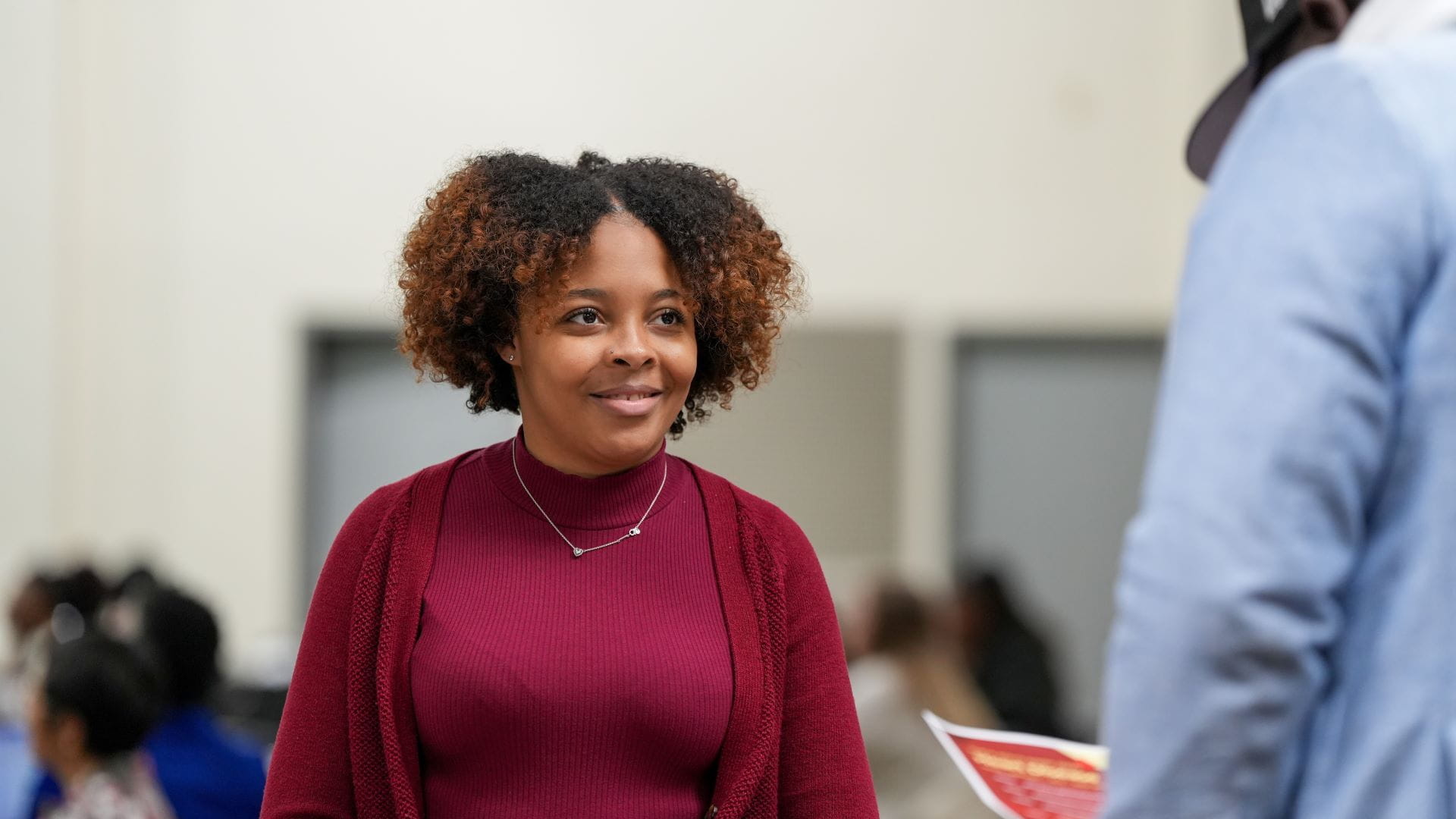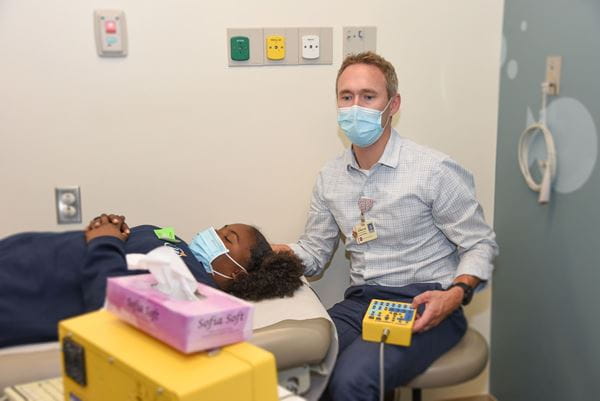Creating critical continuity for sickle cell patients

Matthew Harris May 29, 2024
KAMILLE WARE is always prepared.
At just 23 years old, she has a plan for when the throbbing pain strikes in her lower back, when it seeps into her midsection, and moves down her legs.
“I keep cardigans everywhere,” Ware said. “I have one in my car, all over my house.” In her office at Martin University, she keeps a blanket or a heating pad handy. “Heat is my friend.”
These are the simple tricks that Ware uses to manage her sickle cell disease, an inherited condition that affects red blood cells and their ability to carry oxygen.
Ware considers herself fortunate. She grew up on the west side of Indianapolis, only a short drive from expertise at Riley Hospital for Children. She maintained that proximity as she earned degrees at Marian University. And now, her commute to adult care is just five miles from her job as a public health coordinator for the National Center for Racial Equity and Inclusion.
“I've always stayed close by,” Ware said. “All my doctors are here, and I wanted it to stay that way in case something happened.”
Unfortunately, many of the 1,700 Hoosiers diagnosed with sickle cell struggle to strike such a meticulous balancing act. Many rely on care only available at Indiana University School of Medicine but accessing lifespan care means overcoming physical distances from knowledgeable providers as well as entrenched social and economic challenges to care.
Sickle cell mainly afflicts Black individuals, who might be underinsured and who may harbor deep distrust of health care. Their symptoms and unpredictable hospitalizations pose challenges around holding steady work, creating financial stress, housing instability and food insecurity.
Now, though, IU School of Medicine is slowly becoming a haven for care, with a handful of researchers striving to find new treatments. They do this work at a place that ranks among the top public medical schools in research funding and in a city where multiple hospitals combine to serve every patient.
 “The principle here is lifespan care,” said Andrew O’Brien, MD, a hematologist and assistant professor of clinical medicine. “The patient may physically move and may have to change their doctor, but the team taking of care of them is the same.”
“The principle here is lifespan care,” said Andrew O’Brien, MD, a hematologist and assistant professor of clinical medicine. “The patient may physically move and may have to change their doctor, but the team taking of care of them is the same.”
For many sickle cell patients, finding a physician versed in their condition proves the biggest challenge. Surveys of primary care doctors report that most are uncomfortable treating it. And many in private practice don't accept Medicaid, which 80% of sickle cell patients commonly rely on for insurance coverage.
Assuming a patient finds a provider, usually a hematologist, they must face a disease that can affect multiple systems within the body.
Managing care for sickle cell disease becomes an act of deft orchestration involving a neurologist, pulmonologist, and ophthalmologist. All those physicians rarely practice in the same network, much less the same location.
Beyond Indianapolis, IU School of Medicine is piloting telehealth programs in Evansville and Fort Wayne to reduce the need to travel long distances for care. Under this model, a patient would visit a location to join a primary care provider and talk with an expert in Indianapolis. IU is also exploring virtual visits, where patients use a device mailed to them to help with specialist consults.
Even though her office is just 15 minutes away from her providers, Ware's care involves tricky logistics. To check in with her hematologist, Ware visits IU’s Melvin and Bren Simon Comprehensive Cancer Center. To see her pulmonologist, she goes to Sidney and Lois Eskenazi Hospital. To see an ophthalmologist, she must go outside her insurance network.
Despite the complicated logistics, Ware is an outlier. Nearly 70 percent of sickle cell patients don't see any specialist. And for many, that means their care veers off course.
 “The disease complications are unpredictable,” said Seethal Jacob, MD, an assistant professor of pediatrics at IU School of Medicine. “As patients get older and start to work, the unpredictable nature of pain and hospitalizations may mean they lose their job.”
“The disease complications are unpredictable,” said Seethal Jacob, MD, an assistant professor of pediatrics at IU School of Medicine. “As patients get older and start to work, the unpredictable nature of pain and hospitalizations may mean they lose their job.”
That can be the start of a frustrating cycle. Studies have found almost 60 percent of sickle cell patients are grappling with an immediate financial crisis; one in five confront housing instability. As a result, many individuals wind up with long gaps in care.
When these patients experience severe symptoms, trips to the emergency room become a stopgap. But that means being treated by busy attending physicians who lack a deep knowledge of sickle cell. Often, those physicians assume the worst: A patient is putting on an act to obtain pain medication. Over time, such experiences erode faith in the health care system.
“There's a huge disconnect in how children with sickle cell are viewed and how adults are viewed,” O'Brien said. “When you're consistently mistreated, it creates profound distrust. That's the foundation of what we're trying to undo. We have to demonstrate to them there are ways to help.”
It is frequently the result of what can be a stilted transition in care.

At IU, there's sturdy infrastructure in place to care for children with sickle cell disease. Jacob heads up a nine-person team that includes two nurse educators, a social worker, a transition coordinator, and a psychologist. Collectively, they care for more than 400 patients around the state, handling up to 60 weekly visits.
Around the time a patient enters high school, that team begins preparing them to take control of their care. For example, a nurse educator helps develop vital skills: how to describe symptoms, track medications, ask follow-up questions, and balance appointments. Around the same time, the team starts holding “cross-collaboration conversations” with physicians like O'Brien.
Starting at age 18, a patient like Ware sees an adult and pediatric provider simultaneously. Four years later, the handoff is completed. That sounds fine in theory. “I'd had the same doctors for a good portion of my life,” Ware recalled. “Once you have someone who knows your disease, you don't have to explain things. There's a shorthand. You're just comfortable.”
When a patient does come to O'Brien, the early work is heavily administrative. He fills gaps in medical history, ascertains what medications a patient has tried, and uses that information to start coordinating with peers in different disciplines. And he must do all that while slowly winning over a skeptical patient's confidence.

“Our patients need multiple consults,” O'Brien said. “They need MRIs, urine testing, blood testing, and eye exams. There are multiple appointments, and we ask a lot of them just to keep up with a baseline understanding of their disease. We try to consolidate things as much as we can or bring them together in one place, but it's immensely challenging.”
That’s why O'Brien and Jacob have fleshed out a vision for a sickle cell center, which is not so much a physical space as a robust staff dedicated to integrated care. Ideally, it would wrap in 30 staffers and employ a pharmacist, nutritionist, and physical therapist. Patients would also meet with a “psychosocial team” to keep tabs on a patient's employment and housing.
Addressing mental health would also fill a need often omitted in care plans. Ware considers herself fortunate to have stable family support and skilled providers, but empathy alone can't resolve the frustration and anxiety created by her disease. “A lot of them don't understand what it is to be in your early 20s and have these chronic problems,” Ware added.
Still, establishing a Sickle Cell Center of Excellence would likely require substantial philanthropic support. Doing so would offer benefits beyond lowering barriers to care. For one, it would allow medical students to rotate through during clerkships and gain early exposure to caring for sickle cell patients.
Creating a large pool of patients would also give IU an edge in the competition for national funding that's a fraction of what's needed. Cystic fibrosis—far less common than sickle cell disease—receives 10 times the research funding from the National Institutes of Health. Yet a slice of coveted financing has finally reached the School of Medicine.
In January, Ankit Desai, MD, earned a $3 million grant to test whether an existing drug used for high blood pressure can ease sickle cell symptoms like chest pain, dizziness, and shortness of breath. Propranolol halts the release of stress hormones, slowing a patient's heartbeat and making the organ's lower chambers less likely to ship out blood that lacks enough oxygen.
“Evaluating a therapeutic that has already been consumed by millions for other diseases could help accelerate the potential use in patients with sickle cell more quickly,” said Desai, an associate professor of medicine at the school's Krannert Cardiovascular Research Center.
It would also add vital diversity to the treatments O’Brien prescribes, such as hydroxyurea for acute chest syndrome or voxelotor to lower the risk of anemia by preventing sickle cells from clumping together. “None of them are amazing,” O'Brien said. “But they do have a benefit and can improve a patient's life.”
All of those aspirations sound great to Ware, whose early experiences as an adult juggling her aspirations, along with her disease, have only reinforced the crucial role IU plays.
“Having a hub would make that so much easier for us,” Ware said. “It would really help families like mine to have that one-stop shop for all the resources and care they need.”
Matthew Harris
Matthew Harris is a communications specialist in the Office of Gift Development. Before joining the School of Medicine in 2015, he was a reporter at newspapers in Pennsylvania, Arkansas, and Louisiana. He currently lives in Indianapolis with his wife and two basset hounds.